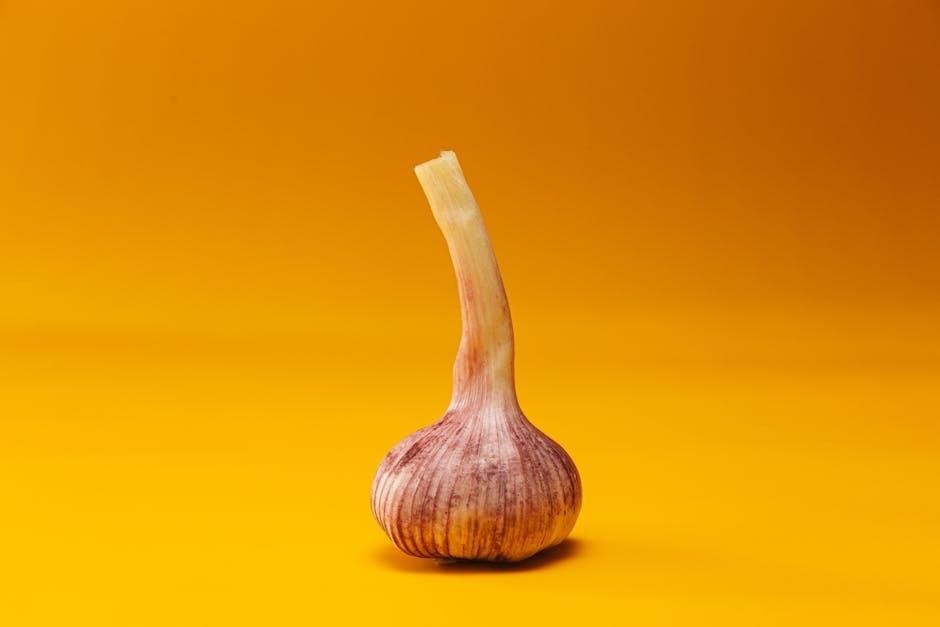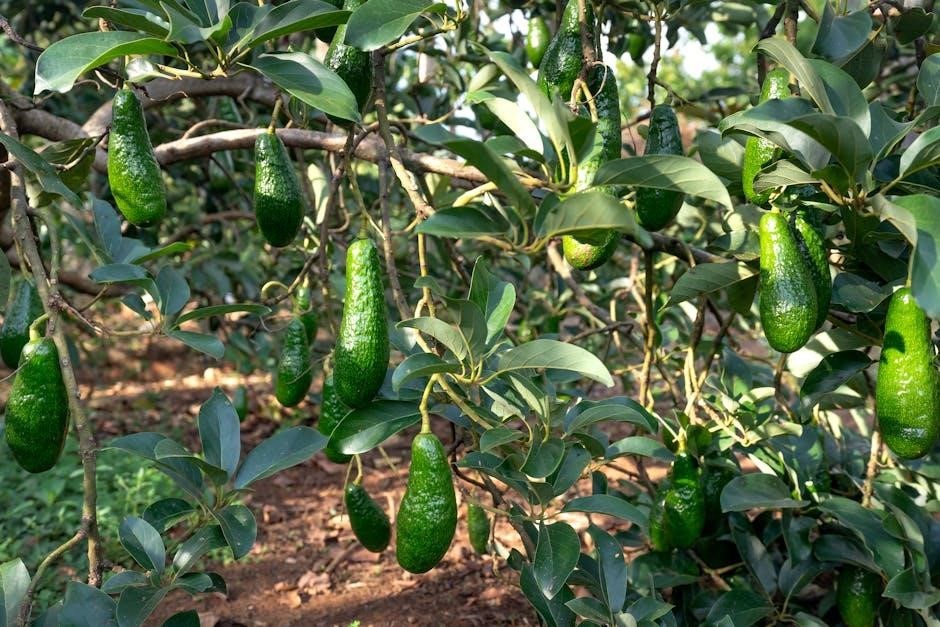Food chains and food webs are essential concepts in ecology, illustrating energy flow between organisms. A food chain shows a linear sequence of feeding relationships, while a food web represents multiple interconnected chains. Both highlight producers, consumers, and decomposers, forming the foundation of ecosystem dynamics. These tools help students understand how energy transfers and sustains life, making them vital for biology education. Worksheets and answer keys provide practical learning opportunities to explore these concepts deeply.
1.1. Definition of Food Chains
A food chain is a linear sequence representing the flow of energy from one organism to another through feeding relationships. It begins with producers (plants or algae) that make their own food via photosynthesis. Each subsequent level represents consumers, such as herbivores and carnivores, which obtain energy by eating other organisms. For example, a grassland food chain might be: grass → rabbit → fox; Food chains illustrate how energy moves through ecosystems, with each level transferring a portion of energy to the next, highlighting the interconnectedness of species. Worksheets often include examples like this to help students understand the concept, with answer keys providing correct identifications of producers, consumers, and trophic levels to assess comprehension.
1.2. Definition of Food Webs
A food web is a complex network of interconnected food chains that illustrate the multiple feeding relationships within an ecosystem. Unlike a food chain, which is linear, a food web shows how organisms can be part of several food chains simultaneously. For example, a single plant may be eaten by multiple herbivores, which in turn are prey for various carnivores. This interconnectedness demonstrates the diversity of energy flow pathways in an ecosystem. Worksheets often depict food webs to highlight the dynamic and interdependent nature of species, with answer keys providing insights into how energy flows through these networks. This helps students understand the ecological balance and resilience of ecosystems.
1.3. Key Differences Between Food Chains and Food Webs
A food chain is a linear sequence of organisms showing a single pathway of energy transfer, while a food web is a complex network of multiple interconnected food chains. Food chains represent a specific pathway, whereas food webs depict all possible feeding relationships in an ecosystem. This interconnectedness highlights the adaptability and resilience of ecosystems. Worksheets often compare these concepts, with answer keys emphasizing how food webs provide a more comprehensive view of energy flow compared to the simplicity of food chains.

Understanding the Food Web Worksheet
The food web worksheet helps students understand ecosystems by illustrating interconnected food chains and energy flow. It connects species, showing how they interact and depend on each other.
2.1. Purpose of the Worksheet
The food web worksheet is designed to help students comprehend the intricate relationships within ecosystems. It aims to teach how energy flows through trophic levels, from producers to consumers, and how species depend on each other. The worksheet also highlights the interconnectedness of food chains, forming a food web. By completing it, students gain insights into ecological balance, predator-prey dynamics, and the roles of decomposers. It serves as a practical tool for visualizing complex concepts, fostering critical thinking and problem-solving skills in biology and environmental science studies.
2.2. Structure of the Worksheet
The food web worksheet is structured to guide students through analyzing and constructing food webs. It typically includes labeled diagrams, fill-in-the-blank exercises, and short-answer questions. Sections focus on identifying producers, consumers, and decomposers, as well as mapping energy flow. Some worksheets include word banks or concept maps to aid understanding. Visual activities, like drawing arrows to represent predator-prey relationships, are common. The structure promotes step-by-step learning, ensuring students grasp how species interact within an ecosystem and how food webs differ from food chains.
2.3. Skills Assessed in the Worksheet
The worksheet evaluates critical thinking and analytical skills through activities like identifying trophic levels and energy flow. It assesses the ability to distinguish between food chains and food webs, as well as recognize producers, consumers, and decomposers. Students demonstrate understanding of ecological relationships and nutrient cycling. Problem-solving skills are tested through diagram-based questions and labeling exercises. The worksheet also measures the ability to interpret visual data and apply concepts to real-world scenarios, preparing students for advanced ecological studies.

Analyzing a Food Chain
Analyzing a food chain involves identifying producers, consumers, and their trophic levels, understanding energy flow, and recognizing how each organism contributes to the ecosystem.
3.1. Identifying Producers and Consumers
Producers, such as plants and algae, form the base of food chains by converting sunlight into energy through photosynthesis. Consumers, like herbivores and carnivores, rely on producers for food. Primary consumers eat producers directly, while secondary consumers eat other animals. Decomposers, though not part of the food chain, break down organic matter. Understanding these roles helps in mapping energy flow and interdependencies within ecosystems, which is crucial for analyzing food chains effectively.
3.2. Understanding Trophic Levels
Trophic levels represent the feeding positions of organisms in a food chain. Producers, like plants, occupy the first trophic level, converting sunlight into energy. Herbivores, such as deer, form the second level, while carnivores like wolves are in the third. Each level transfers about 10% of the energy from the previous one, creating an energy pyramid. Understanding trophic levels helps in analyzing how energy flows through ecosystems and predicting the impact of changes in populations on the food web.
3.3. Examples of Food Chains
A food chain illustrates the flow of energy from one organism to another. Examples include:
– Grasslands: Grass (producer) → Mouse (herbivore) → Owl (carnivore).
– Desert: Cactus (producer) → Lizard (herbivore) → Snake (carnivore).
– Ocean: Phytoplankton (producer) → Zooplankton (herbivore) → Small Fish (carnivore). These chains simplify ecosystem interactions, showing how energy moves through trophic levels.
Constructing a Food Web
A food web is built by mapping interactions between organisms, showing how energy flows through interconnected food chains. It visually represents ecosystem balance and interdependence.
4.1. Combining Multiple Food Chains
To construct a food web, multiple food chains are combined, illustrating how organisms interact within an ecosystem. Each chain connects through shared producers or consumers, creating a complex network. This approach reveals the interconnectedness of species and their roles, such as predators, prey, or decomposers. By merging chains, the food web highlights ecosystem balance and energy distribution, showing how each organism contributes to the overall structure and function of the environment.
4.2. Identifying Key Components
A food web consists of producers, consumers, and decomposers, with arrows indicating energy flow. Producers, like plants, form the base, while consumers, such as herbivores and carnivores, follow. Decomposers, like fungi, break down organic matter. Identifying these components helps in understanding ecosystem dynamics and energy distribution. This step is crucial for accurately representing how species interact and depend on one another within the food web, ensuring a clear and comprehensive visualization of the ecosystem’s structure and function.
4.3. Visual Representation of a Food Web
A food web is visually represented using interconnected arrows and boxes. Each box represents an organism, and arrows indicate the direction of energy flow. Producers are at the base, while consumers and decomposers branch out. The diagram shows multiple food chains overlapping, illustrating species interactions. Clear labels and colors can differentiate producers, primary consumers, and decomposers. A legend often clarifies symbols, ensuring the food web is easy to interpret. This visual tool helps students understand complex ecosystem relationships and energy pathways effectively.
Energy Flow in Ecosystems
Energy flows through ecosystems from producers to consumers, with each level transferring only a fraction of energy. This unidirectional process sustains life and supports ecosystem functioning.
5.1. Energy Transfer Between Organisms
Energy transfer between organisms occurs through feeding relationships, where producers like plants convert sunlight into energy via photosynthesis. Consumers obtain energy by consuming other organisms, with herbivores eating plants and carnivores preying on other animals. Decomposers break down dead organisms, recycling nutrients. Energy transfer is inefficient, as only 10% of energy is passed to the next trophic level, leading to a hierarchical energy pyramid. Understanding this process is crucial for analyzing food webs and ecosystem balance.

5.2. Role of Producers in Energy Flow
Producers, such as plants, algae, and some bacteria, are the foundation of energy flow in ecosystems. They convert sunlight into chemical energy through photosynthesis or chemosynthesis, forming the base of the food web. This energy is then transferred to herbivores when they consume producers and further to carnivores through predation. Producers are essential as they initiate energy flow, supporting all life in the ecosystem. Their efficiency in energy conversion directly impacts the stability and productivity of the food web.
5.3. Constructing an Energy Pyramid
An energy pyramid visually represents the flow of energy through an ecosystem, with producers at the base and higher trophic levels above. Each tier shows energy stored, decreasing as it moves upward due to energy loss. The widest level (producers) holds the most energy, while the narrowest (top predators) holds the least. This hierarchy illustrates energy efficiency and the limited energy available at higher levels. Constructing an energy pyramid helps students understand ecosystem dynamics and energy distribution in food webs.

Trophic Levels and Their Importance
Trophic levels represent the feeding positions of organisms in a food web, from producers to top predators. They are crucial for understanding energy flow and ecosystem balance.
6.1. Primary Producers
Primary producers, such as plants, algae, and phytoplankton, are organisms that form the base of food webs. They produce their own food through photosynthesis, converting sunlight into energy. These organisms are crucial as they provide the energy and nutrients necessary for all other trophic levels. Without primary producers, ecosystems would lack the foundation to sustain life. They are the starting point for energy transfer in food chains and webs, making them indispensable for maintaining ecological balance and supporting biodiversity.
6.2. Primary Consumers
Primary consumers are herbivores that feed directly on primary producers, such as plants and algae. They are the second trophic level in a food web and play a vital role in energy transfer. Examples include insects, zooplankton, and herbivorous fish. These organisms obtain energy by consuming producers and convert it into a form usable by higher trophic levels. Primary consumers help regulate producer populations and serve as a food source for secondary consumers, maintaining the balance of the ecosystem. Their role is essential for the flow of energy through the food web.
6.3. Secondary and Tertiary Consumers
Secondary consumers are carnivores that feed on primary consumers, occupying the third trophic level. They include animals like small mammals, birds, and predatory fish. Tertiary consumers are apex predators, such as large mammals or birds of prey, at the fourth trophic level. These consumers regulate prey populations and maintain ecosystem balance. They are essential for energy flow and nutrient distribution, ensuring the stability of food webs. Their presence influences the overall structure and health of ecosystems, making them critical components in food web dynamics.

Decomposition and Nutrient Cycling
Decomposition breaks down organic matter, releasing nutrients for reuse. Nutrient cycling sustains ecosystems by returning essential elements to producers, ensuring continuous plant growth and food web stability.
7.1. Role of Decomposers
Decomposers, such as bacteria and fungi, play a crucial role in breaking down dead organic matter. They release nutrients like carbon, nitrogen, and phosphorus back into the ecosystem, replenishing soil and water. This process ensures that nutrients are available for producers, maintaining the balance of the food web. Decomposers also contribute to energy transfer by converting complex organic molecules into simpler forms, supporting the continuous cycle of nutrient availability and sustaining life in ecosystems.
7.2. Nutrient Cycling in Ecosystems
Nutrient cycling refers to the continuous transfer of nutrients through ecosystems. Decomposers break down organic matter, releasing nutrients like carbon, nitrogen, and phosphorus into the soil and water. Producers absorb these nutrients, initiating energy flow through the food web. Consumers obtain nutrients by eating producers or other organisms, and nutrients are returned to the environment through waste, death, and decomposition. This cycle ensures nutrient availability for future generations, maintaining ecological balance and supporting biodiversity.

Interactions Within Food Webs

Interactions within food webs are vital for ecosystem functioning, maintaining balance, and supporting biodiversity. They involve energy and nutrient exchanges between organisms at different trophic levels.
8.1. Predator-Prey Relationships
Predator-prey relationships are central to food web dynamics, influencing population sizes and ecosystem balance. Predators hunt prey for energy, while prey develop defenses to survive. These interactions drive evolutionary adaptations, ensuring biodiversity. For example, wolves prey on deer, regulating deer populations and maintaining forest health. Worksheets often depict these relationships visually, helping students analyze how changes in predator or prey numbers affect the entire food web. Understanding these dynamics is crucial for grasping ecological stability and interdependence within ecosystems.
8.2. Symbiotic Relationships
Symbiotic relationships involve close interactions between species, shaping food web dynamics. These include mutualism (both benefit), commensalism (one benefits, the other is unaffected), and parasitism (one benefits, the other is harmed). For example, clownfish and sea anemones exhibit mutualism, while remora fish attach to sharks for food scraps, showing commensalism. Parasites like tapeworms rely on hosts for survival. Worksheets often highlight these relationships to illustrate how species depend on each other, impacting ecosystem balance and energy flow.

Advanced Concepts in Food Webs
Explore complex interactions, such as ecological balance, trophic cascades, and energy flow efficiency in food webs, essential for understanding advanced ecosystem dynamics and worksheet solutions.
9.1. Ecological Balance
Ecosystems maintain ecological balance through interactions within food webs, ensuring biodiversity and nutrient cycling. Producers, consumers, and decomposers work together to sustain stability. Disruptions, like invasive species or climate change, can alter this balance, affecting energy flow and population dynamics. Understanding ecological balance is crucial for analyzing food web worksheet answers, as it highlights the interconnectedness of organisms and their roles in maintaining ecosystem health. This concept is vital for predicting how changes in one part of the web may impact the entire ecosystem.
9.2. Trophic Cascades
Trophic cascades occur when changes in one trophic level significantly impact other levels, creating a ripple effect through the ecosystem. For example, the introduction or loss of a top predator can alter herbivore populations, which in turn affects vegetation. These cascades highlight the interconnectedness of food webs and their sensitivity to changes. Analyzing trophic cascades in a food web worksheet helps students understand how ecosystems maintain balance and respond to disturbances, emphasizing the delicate interplay between predators, prey, and their environments.
Answer Key and Worksheet Solutions
The answer key provides correct solutions for the food web worksheet, highlighting common mistakes and offering tips for improvement to enhance understanding and accuracy.
10.1. How to Use the Answer Key
To effectively use the answer key for the food web worksheet, start by comparing your answers with the provided solutions; Review each question, ensuring you understand the correct responses and the reasoning behind them. Pay attention to explanations for complex concepts, such as trophic levels or energy flow. Use the key to identify patterns in your mistakes and focus on improving those areas; This process helps reinforce learning and enhances your understanding of food web dynamics for future assignments.
10.2. Common Mistakes to Avoid
When working with the food web worksheet, common mistakes include misidentifying producers and consumers, incorrectly assigning trophic levels, and overlooking decomposers’ roles. Students often mix up energy flow directions or confuse predator-prey relationships. To avoid errors, carefully review each question, ensuring understanding of concepts like food chain hierarchy and nutrient cycling. Double-checking answers and seeking clarification on confusing topics can help prevent these mistakes and improve overall performance in the worksheet.
10.3. Interpreting the Answer Key
Interpreting the answer key for the food web worksheet involves understanding how each question aligns with the correct answers. Pay attention to color-coding or symbols used to highlight errors or correct responses. Reviewing the key helps identify patterns in mistakes, such as mislabeling trophic levels or confusing producers with consumers. Use the key to reinforce learning by focusing on areas needing improvement. This process ensures a clearer grasp of food web concepts and improves accuracy in future assignments.

Case Studies and Practical Applications
Case studies and practical applications provide real-world insights into food web dynamics. They demonstrate how worksheets can model ecosystems, aiding in ecological research and education effectively.
11.1; Marine Food Web Examples
Marine food webs illustrate interconnected relationships in ocean ecosystems. Phytoplankton serve as primary producers, supporting zooplankton, which are consumed by small fish like sardines and anchovies. Larger fish, such as tuna and mackerel, feed on these, while apex predators like sharks and dolphins occupy the top trophic levels. Seabirds and marine mammals also play crucial roles. Decomposers, such as bacteria and fungi, break down organic matter, recycling nutrients. These examples help students visualize energy flow and understand the delicate balance within marine ecosystems through food web worksheets.
11.2. Terrestrial Food Web Examples
Terrestrial food webs highlight interactions in land ecosystems. Grasslands feature grasses as producers, supporting herbivores like rabbits and deer, which are preyed upon by coyotes and hawks. Forests showcase trees and shrubs as producers, with insects and squirrels as primary consumers, followed by predators like owls and foxes. Decomposers, such as fungi and bacteria, recycle nutrients. These examples demonstrate energy flow and interdependence in terrestrial ecosystems, aiding students in understanding complex food web dynamics through structured worksheets.
Educational Resources
Explore educational resources like textbooks, websites, and interactive modules for in-depth food web studies. These tools provide comprehensive guides and activities to enhance learning experiences.
12.1. Recommended Worksheets
Utilize food web worksheet answer key PDFs to enhance learning. These resources offer structured exercises, diagrams, and answers for self-assessment. They cover topics like food chains, energy flow, and trophic levels. Visit educational websites or platforms like Teachers Pay Teachers or Khan Academy for downloadable materials. These worksheets are ideal for students to practice identifying producers, consumers, and decomposers. They also include visual aids like food web diagrams to help students understand complex relationships in ecosystems. Regular practice with these worksheets improves comprehension and retention of ecological concepts.
12.2. Online Tools for Learning
Enhance your understanding of food webs with online tools designed for interactive learning. Platforms like Khan Academy and National Geographic offer simulations and quizzes to visualize food chains and energy flow. Tools like PhET Interactive Simulations provide engaging models to explore trophic levels and ecosystem dynamics. Additionally, food web diagram builders allow students to create and analyze their own food webs digitally. These resources make complex concepts accessible and fun, ensuring a deeper grasp of ecological relationships and energy transfer in ecosystems.


